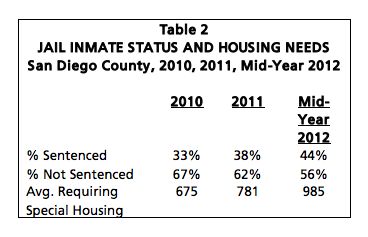Realignment Changes Corrections Landscape In California


San Diego jails have been facing, and will continue to face, adjustments as the recent state-wide "realignment" changes corrections on all levels. The realignment process, implemented exactly a year ago, calls for nonviolent, nonsexual felons to serve their sentences in county jails rather than state prisons. Realignment aims to create a more cost-effective corrections system that will maintain or further reduce California's historically low crime rate.
In addition to increasing budget constraints, California faced a difficult decision following a Supreme Court ruling in Plata v. Brown, in which the plaintiff accused prison medical services to be insufficient and, thus, was in violation of constitutional rights under the eighth amendment banning cruel and unusual punishment. The State had no choice but to divert responsibility of incarceration and other corrections activity, such as parole, to the county level so as to reduce prisoner populations and relieve stressed prisons.
Although state prisons have seen a significant drop in incarcerations in recent months, down to 150% overcapacity in July versus 180% overcapacity last October, county jails will undoubtedly see a sharp increase in the number of inmates they need to house. Many of these county jails are ill-equipped to house inmates for the long-term.
Whether this will create a crisis within county jails is yet to be seen, although many already face overcrowding. Santee's Las Colinas detention center is undertaking a controversial $221 million project to expand the facility. More than half the funds for that project are being put up by the county. However, officials project a $1.5 billion budget reduction on the state prison level.
CCPOA Press Secretary JeVaughn Baker highlights that, “If given the appropriate resources, the realignment could be a very effective tool towards creating a more efficient prison system.” Commander Will Brown, who is overseeing realignment in San Diego County, maintained this level-headed opinion on the matter, yet is realistic about the challenges of a heavier caseload. The state has maintained a 70% recidivism rate over three years and San Diego is determined to reduce this rate, which is also a goal of realignment as a whole.
“Our department sees realignment as a challenge,” says Brown. The Sherriff's department believes that the county level is most appropriate for beginning to lower the state’s 70% recidivism rate and keep people out of the corrections cycle for life.
Commander Brown notes, “For every offender who becomes crime free, there will be a substantial savings to the criminal justice system.” As such, adequate programming to limit the number those that could become repeat offenders is a priority for the county. San Diego will be converting the East Mesa Detention Facility into a reentry facility to promote rehabilitation over incarceration. The State also emphasizes the importance of rehabilitation, as it will be absolutely key to resolving the California corrections crisis.
Baker echoes this concern. “[The local authorities are] exhausting their resources at the county level as they attempt to deal with this overwhelming shift. Dollars that may be saved at the state level will certainly be spent at the local level.”
 1170: Inmates moved from prison to county jail
1170: Inmates moved from prison to county jailPRO: Post-release offenders
Source: SANDAG
Since the success of the realignment policy relies heavily on proper funding, it will remain a significant challenge to the State, to counties, and the criminal justice system as a whole.
As such, careful planning and research will be essential to ensuring the responsible expenditure and adequate investment needed for the program’s success. According to an in depth analysis by the Public Policy Institute of California (PPIC), a new state entity called the Board of State and Community Corrections (BSCC) has been charged with the task of developing a plan to track realignment's effectiveness in the long-run.
The report also details the measurable outcomes that will be necessary to track in order to assess realignment. These include: crime rates, recidivism, litigation processes, jail versus prison populations, early releases, and fiscal implications. PPIC emphasizes, “It is critical that the state fund careful, ongoing evaluation.”
The San Diego County Sherriff’s department is determined to make realignment a beneficial policy for the city. To do so, the department is set to hire an additional 2,000 employees, and Commander Brown notes that despite overall workloads in jails having increased due to inmate population levels, staff schedules have not suffered.
This seems to be good news for realignment, and the state. In a statement to IVN Mr. Baker notes that:
[The state] still numerous overcrowding situations in our facilities and we continue to lose officers due to layoffs and the budget crisis that we face in the state. The conditions inside of the prisons remain volatile, as we have witnessed in the last few weeks in the number of riots that have taken place. Appropriate staffing levels are always a high concern of ours and we understand that as the inmate population is reduced so are the staffing requirements. However, our facilities were understaffed prior to the inmate reductions and we are still suffering cuts.Source: SANDAG

A report by the SANDAG’s Criminal Justice Research Division states that the “average number of realignment offenders detained locally has increased. In addition, the average number of inmates requiring specialized housing has gone up, reflecting the greater needs of the realignment population.”
Commander Brown also cites the special needs, and the longer incarcerations, of the realignment population as one of the policy’s greatest challenges to the county.
Crime, as a whole, is also up slightly since last year but Cynthia Burke, the Division’s director, says that despite these figures it might be too early to determine the exact cause and it would not be appropriate to pinpoint realignment as the main culprit.
The coming election be a serious game-changer for the State's corrections reform plan. Proposition 34 aims to to rid the State of the costly death penalty and Proposition 36 is seeking the elimination of the three strikes law. Make sure to read more about these important initiatives:




